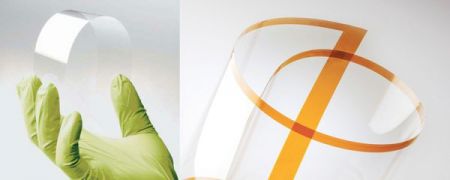Corning's major announcement at SID was the new Willow glass product. This is an ultra-slim (50 um and 100 um) flexible glass that can support backplanes and color filters in both LCD and OLED panels. Willow glass can withstand temperatures up to 500 degrees Celsius, and can be used in roll-to-roll production processes.
Corning says that in the near future Willow glass can be used to produce rigid OLEDs panels in processes that need flexible glass (such as roll-to-roll), and in the long term it may also lead to actual flexible panels based on glass. Glass have several advantages over plastics, mainly that it's a better barrier and it can result in better displays in terms of resolution, backplane speeds, etc. However the major disadvantage is that it can be shattered, unlike plastic-based displays.
Willow glass is not intended to be used as cover glass. In today's typical OLED display, several glass layers are used: a substrate layer, an encapsulation layer and a cover glass. The cover glass is different as it's usually much tougher (Corning's Gorilla glass is one example of tough cover glass) and it's also optional.

Corning intends to start producing Willow glass in Q3 2012, in one meter wide rolls (and up to 300 meters long). They will also offer ITO-coated Willow glass rolls (0.5 meter wide) in Q4 2012.
Corning was also showing their Lotus glass, which is currently the best solution for LTPS OLEDs according to Corning. Lotus replaced the older JADE glass product that's no longer available. It turns out that the production plant in Korea (jointly launched with Samsung) is now up and running, and Samsung is already using Lotus glass panels from that plant in their OLED smartphones and TV panels.
Comments
I am really interested in a good reason, why display makers would use a R2R process for AMOLED production,
1) when they have sheet processes up and running
2) while R2R processes will likely cause increased downtime and massive yield problems for years until suitable processes are established and available
3) other cost factors are dominant over processing cost, e.g. encapsulation and substrates and "willow glass" is not likely to be cheaper because it is less (thinner). So there is no driving force to make asian display-makers get fancy for R2R processing.
It is either a never or a very long way until R2R production for electronics will be as easy and cheap as media printing (talking just about the processing itself, not materials, not licenses...).
Probably around the time, when you splice in flexible glass as if it was paper:
http://www.youtube.com/watch?v=wYRGiXMUzA4
1. "Up and running" is a relative term when you talk about OLED manufacturing. Sure, Samsung and a handful of others have lines that can support a certain level of large volume manufacturing, but compared to the projected future volumes the currently installed capacity is minimal. So if all goes according to plan they will have to invest in new facilities anyway.
2. Of course R2R processes are currently nowhere near what is needed for large scale production. On the other hand OLED panel prices are also nowhere near to where they need to be for large scale market adoption (other than mobile phone displays). Those 55" TVs look great, but they simply are too expensive. So OLED producers need to bring prices down and at least from my experience even the most ardent supporters of vacuum depositioning I've talked to will tell you that if it works R2R has the potential for significant cost savings in volume production.
Granted, at this point it's a big IF, but you also have to look beyond the display industry: If you think about the PV market R2R production becomes an even bigger cost saver because the areas get larger, since most OLED guys still also dream about OLED PVs this has to be taken into account as well.
So yeah, it will take quite a bit more time and there is a risk that it will never work sufficiently well, but there is also enough reason to go ahead and try it.
Now what I am really wondering about is the flexible glass itself: While stuff like Willow Glass looks nice it still has some major issues, cost being the biggest one. Stability is another one, yeah I know glass manufacturers drum their chests about how robust that stuff is......as long as you don't hit the edges. If you do the stuff breaks even more easily than normal glass. I think that is also why they are careful to talk about real flexible displays based on that stuff: All these ultra-thin glasses are very well as long as they are encased in a rigid housing (think a curved but fixed display) but real flex-displays based on this? I don't really see it.
So from my point of view I think this could be a classic transition technology which will have to find a new niche if and when other encapsulation technologies become mature enough in a couple of years.


This Corning Willow glass will be important for make it possible to manufacturing both large LCD and Amoled displays with Roll-to-roll manufcturing process.
Roll-to-roll process will make it possible to make both larger and small displays very cheap.
Especially Amoleds will be very cheap when Roll-to-roll process will be in large scale in some years
because Roll-to-roll manufacturing process can roll in large size when Ink Jet technology will print out the Amoled displays.